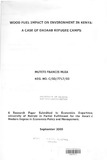| dc.contributor.author | Muteti, Francis M | |
| dc.date.accessioned | 2013-05-03T11:56:59Z | |
| dc.date.available | 2013-05-03T11:56:59Z | |
| dc.date.issued | 2005 | |
| dc.identifier.citation | A Research Paper Submitted to Economics Department, University of Nairobi in Partial Fulfillment for the Award ofMasters Degree in Economics Policy and Management. | en |
| dc.identifier.uri | http://erepository.uonbi.ac.ke:8080/xmlui/handle/123456789/18687 | |
| dc.description.abstract | The environment is impacted by activities undertaken in most countries. In developing countries, poverty has been linked to the destruction of the environment. There are many causes of environmental destruction that necessitates strategies for reducing the rate of degradation. Fuel wood has not been regarded as a major factor in environmental degradation in many parts of the world. Many theories in the past linking fuel wood to environmental degradation have been disapproved through research that shows there has been no serious impact to the environment. These theories are based on various assumptions that have been analyzed in this paper to find out the extent of fuel wood impact on the environment.
The study focuses on Dadaab refugee camps in Garissa District. Their fuel wood practices are used as an experiment to test these theories. This focal area was chosen because it has a big settlement that can be used as an example in relation to other settlements. The area is divided into different regions to show different impacts to different areas based on the distance from the camps.
The study analyses the change in stock in different levels of harvest around the refugee camps. The area is divided into three regions to show the fuel wood use at varying distances from the camps. The first level of seven-kilometer radius indicates severe environmental degradation due to intense fuel wood harvesting. The other levels show some level of sustainability compared to the first level.
A linear model is then estimated using Ordinary Least Square (OLS) to explain the effects of issued fuel wood and stoves on the change in stock. The results of the regression on all levels indicate that issued fuel wood has a positive relationship with change in stock. This shows that increasing the amount of fuel wood issued to refugees will lead to reduced harvest which in turn reduces the
impact on the environment. These results are also applicable to issued stoves. Population has a negative impact on change in stock. However the results are insignificant at all levels.
The study shows that policies focused on issued fuel wood and stoves can be formulated to reduce environmental degradation around major settlements. Policies should also be focused on other forms of energy to reduce harvesting of fuel wood. This could include reduction of taxes on other forms of fuel and energy like kerosene, Solar panels, wind generators and electricity to enable people switch from fuel wood. | en |
| dc.language.iso | en | en |
| dc.title | Wood fuel impact on environment in Kenya: a case of Dadaab refugee camps | en |
| dc.type | Thesis | en |
| local.publisher | Department of Arts-Economics | en |

